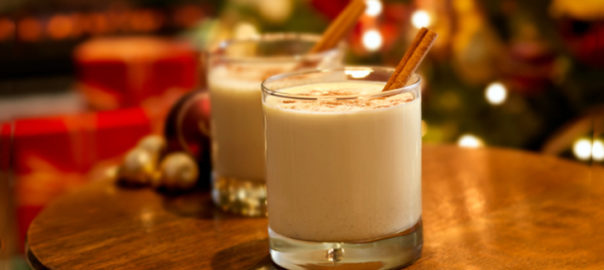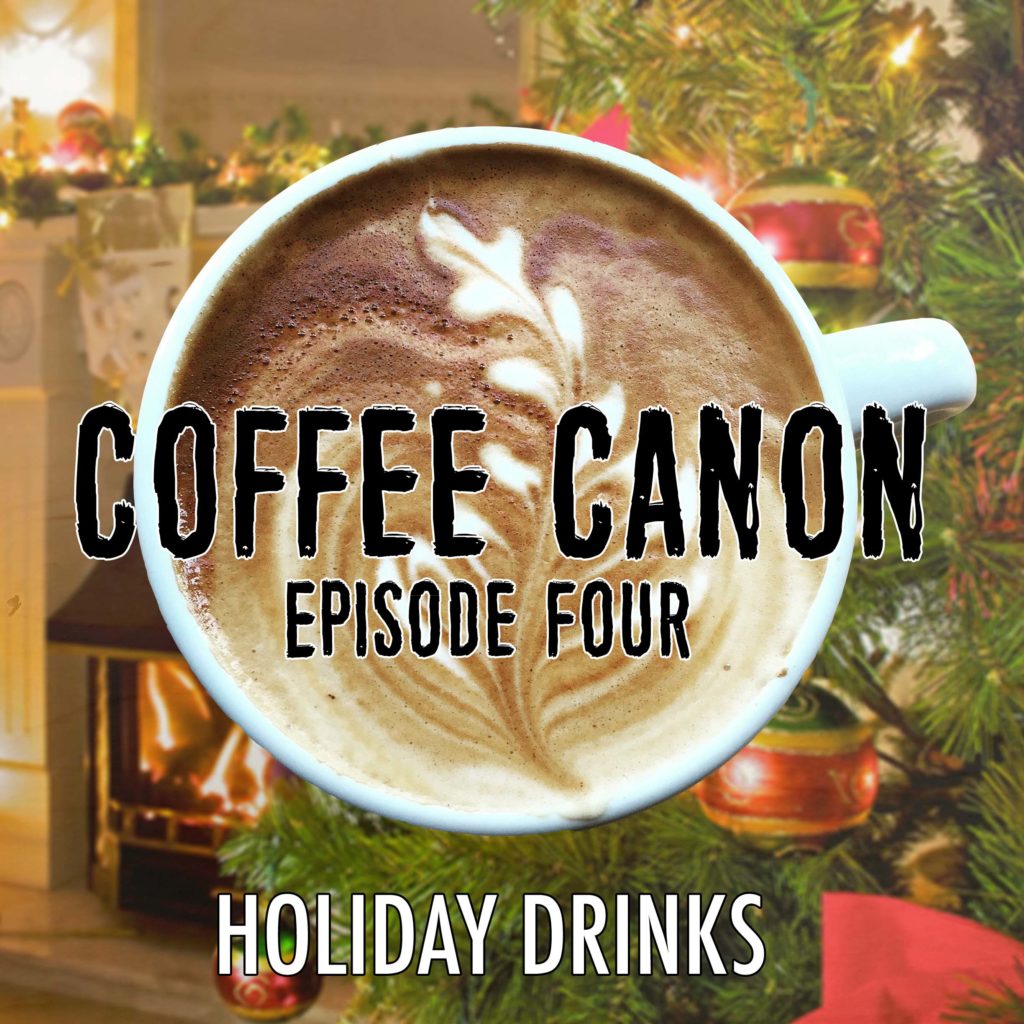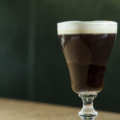Today on the podcast we’re bending the rules a bit and not focusing entirely on coffee. Instead, in the spirit of Christmas, we’re broadening our scope and looking at Holiday drinks as a whole, and the traditions they come with.
We’re focusing on three drinks in particular: the Pharisee, the Tom and Jerry, and Irish Coffee. All three are steeped in Christmas tradition, and the stories surrounding each are as interesting as they are surprising.
If you’re interested in making any of these drinks at home, here are some recipes I recommend:
- The Pharisee (thespruce.com)
- The Tom and Jerry (punchdrink.com)
- Irish Coffee (foodnetwork.com)
Need last minute gift ideas? Check out the Coffee Canon 2017 Holiday Gift Guide, available as a free PDF here.
Episode Four Sources:
- Pharisäer (Pharisee)
- Der “Pharisäer nach Originalrezept” (Translation: The “Pharisee according to original recipe”), anwaltseiten24. Link: http://www.anwaltseiten24.de/rechtsgebiete/kuriose-gerichtsurteile/1/news/der-pharisaer-nach-originalrezept.html
- “Amtsgericht Flensburg – Wieviel Rum macht den echten Pharisäer?” (Translation: “District Court Flensburg – How much rum makes the real Pharisee?”), Wikisource. Link: https://de.wikisource.org/wiki/Amtsgericht_Flensburg_-_Wieviel_Rum_macht_den_echten_Pharisäer%3F
- “Zeitreise: Der Pharisäer-Streit” (Translation: “Time travel: The Pharisee quarrel”), NDR.de (only accessible via web.archive.org). Link: https://web.archive.org/web/20161103213817/https://www.ndr.de/fernsehen/sendungen/schleswig-holstein_magazin/zeitreise/Zeitreise-Der-Pharisaeer-Streit,zeitreise1238.html
- Wikipedia: https://de.wikipedia.org/wiki/Pharisäer_(Getränk)
- DM conversion tables: http://www.history.ucsb.edu/faculty/marcuse/projects/currency.htm#tables
- Converting 1981 US Dollars to 2017 US Dollars: http://www.in2013dollars.com/1981-dollars-in-2017?amount=13.82
- Tom and Jerry
- Wikipedia
- Egg Nog: https://en.wikipedia.org/wiki/Eggnog
- Tom and Jerry: https://en.wikipedia.org/wiki/Tom_and_Jerry_(drink)
- “The Forgotten Christmas Cocktail.” The Atlantic, by Sarah Elton. Link: https://www.theatlantic.com/health/archive/2009/12/the-forgotten-christmas-cocktail/32226/
- “A Regional Oddball, Resurrected for Chilliest of Days.” The New York Times, by Robert Simonson. Link: http://www.nytimes.com/2012/12/12/dining/the-tom-and-jerry-an-odd-ephemeral-drink.html
- “About Those Tom and Jerry Bowls.” PUNCH, by Megan Krigbaum. Link: https://punchdrink.com/articles/about-those-tom-and-jerry-drink-recipe-bowls/
- Wikipedia
- Irish Coffee
- Wikipedia: https://en.wikipedia.org/wiki/Irish_coffee
- “Delaplane honored where he ate, drank and finished his columns / Old friends hang his typewriter in North Beach bar.” SFGate, by Carl Nolte. Link: http://www.sfgate.com/bayarea/article/SAN-FRANCISCO-Delaplane-honored-where-he-ate-2557750.php
- “The man who brought Irish coffee to America.” SFGate, by Carl Nolte. Link: http://www.sfgate.com/bayarea/article/The-man-who-brought-Irish-coffee-to-America-3185886.php
- “Irish Coffee.” Ireland Whiskey Trail. Link: http://www.irelandwhiskeytrail.com/irish_coffee_history_and_recipes.php
- BBC Episode about Stanton Delaplane: http://www.bbc.co.uk/programmes/p00ydsdx
- “The Irish Coffee Story.” The Buena Vista. Link: http://www.thebuenavista.com/home/irishcoffee.html
- Music
- Dee Yan Key – Sleigh Ride III, FreeMusicArchive.org
- Hyson – Silent Knight, FreeMusicArchive.org
- Borrtex – Love & Generosity, FreeMusicArchive.org
- Mystery Mammal – O Come All Ye Faithful, FreeMusicArchive.org
Episode Four Transcript:
In Germany, they take Christmas seriously. Every year, starting in late November and continuing all throughout December, most German towns have giant pop-up outdoor Christmas Markets. They’re complete with small shops, delicious foods, and – of course – warm drinks. The Christmas markets are an old tradition, with history dating back to the 14th and 15th centuries, and their popularity over the years has turned them from a uniquely German custom into something most of Europe participates in. You can find Christmas markets everywhere from Paris to Copenhagen – but the biggest ones are still in Germany.
The most popular drink at German Christmas Markets is called Glühwein – it’s a hot mulled wine that can be served with or without a shot of brandy. As you walk around the markets you’ll see shop owners ladling out cupfuls of Glühwein from giant vats. It’s customary to pay for the drink, along with a deposit for the decorative Christmas mug it comes in. After finishing the drink you can choose to keep the mug, or return it and collect your deposit back.
Today on the podcast we’re bending the rules a bit and not focusing entirely on coffee. Instead, in the spirit of Christmas, we’re broadening our scope and looking at Holiday drinks as a whole, and the traditions they come with. The origins of some of these drinks, like Glühwein, are straightforward: wine tastes good, so hot wine with spices tastes even better when it’s cold outside. Other drinks have a more interesting backstory – like the Pharisäer, another Germany Christmastime alcoholic beverage. The name literally translates to “Pharisee” – yes, a reference to the Biblical sect of Jews who strictly adhered to ancient laws. But the drink is made from sweetened coffee and a shot of brown rum. So what’s with the name?
I’m Colin Mansfield, Merry Christmas and welcome to Coffee Canon.
It was the early 1870s in Nordstrand, Germany – an island that was home to a pastor named Georg Bleyer. Pastor Bleyer hated alcohol, and the local townspeople knew this. To keep the peace, people abstained from drinking while he was around.
On one particular day, Pastor Bleyer had come to the home of a respected local farmer named Peter Johannsen to baptize his new child. Pastor Bleyer finished giving his blessing to the baby, but decided to stick around for a while and enjoy the cozy home. The other guests weren’t pleased with this – they wanted to start drinking in celebration. Suddenly, farmer Johannsen had an idea. He asked one of the young ladies present to prepare cups of coffee, but to put a nice shot of rum in as well – for everyone, except the pastor. Then, to cover up the smell of liquor, he asked that a nice dollop of whipped cream be placed on every drink.
As you can imagine, a few rounds in everyone was starting to feel very cheerful. But then, misfortune struck and Pastor Bleyer discovered that the other cups contained rum. It’s not clear if the tipsy kitchen staff accidentally added rum to the pastor’s drink, or if he was simply suspicious at how everyone seemed to be getting happier. Regardless, the gig was up and the pastor was angry. After tasting the rum he stood up and shouted, “Oh, you Pharisees!” The name stuck.
Now with stories like this, usually I advise taking them with a grain of salt. Time has a way of shifting the names of people and the particulars of how events happened, but in this case, the story seems to have happened the way its told. One article I found was written in German by the great-great-grandson of Pastor Bleyer. He traveled to Nordstrand last year and met the descendants of the Johannsen family. He even went to the farm where the Pharisee story is said to have taken place – it’s since been turned into a cafe. Each person he talked to told the story the same way – how it was passed down to them from their parents.
The Pharisee became a staple menu item in German bars and cafes – and no wonder: its sweet, slightly bitter, and has nice punch of rum – or at least it’s supposed to.
In 1981 a German dentist named Arnold Rothmaler and his wife entered the Fährhaus restaurant in Holnis on the Flensburg Fjord in far north Germany. He and his wife took a seat, then saw a folded up card advertising the Pharisee drink. The card said that the drink was made, “according to the original recipe.” Mr. Rothmaler ordered two Pharisees, but after taking a sip he noted that the drink was weak – he complained to the wait staff, asking how much rum the drink contained. At this point, the restaurant owner, Mr. Wolfgang Wree, got involved, and he replied that the drinks contained 2 centiliters, or about 4 teaspoons, of rum. Mr. Rothmaler pushed back, stating that the original recipe for the Pharisee required more rum, but the restaurant owner wouldn’t relent. The disagreement escalated, and Mr. Rothmaler refused to pay for the drinks, electing instead to take the restaurant owner to court.
Now to put this in context, each drink was priced at 3.50 DM, or Deutsche Marks. In 1981, 7 Deutsche Marks converted to $13.82 US. Taking inflation into account, that’s $37.22 today.
Arnold Rothmaler got his day in court. The presiding judge, Peter Jacobsen, determined that the only way to know for sure whether or not the Pharisees made with 2cl of rum were weak, was to taste them. The judge ordered several variations of the drink be made, then tasted them with the defendant (Mr. Rothmaler) and the plaintiff (Mr Wree, the restaurant owner). In the end, the judge sided with the defendant – Mr. Rothmaler. I was able to dig up the transcript from the court proceedings – it’s hilarious to read the judge’s verdict in official court documents. Here’s an excerpt. It’s translated from German, but I think you’ll get the point:
“…the plaintiff had rejected the rectification by adding more rum. The fact that the defendant had the opportunity to order more rum in order to make the drink more alcoholic is certainly correct, but here it is insignificant; the defendant would then have accepted the defective performance and would have been additionally charged with a further purchase price claim. The served “Pharisees” were deficient . They have deviated significantly in their quality from what characterizes the “Pharisee” according to the original recipe. It is known to the courts that there are other recipes for this drink that originated on the island of Nordstrand. The original recipe, to which the folding card refers, is based on a drink that is “highly alcoholic” and therefore clearly tastes the rum additive. Because the drink is due to the “hearty” and “decent shot of rum” as “delicious drink warm body and soul.” This is not the case with two centiliters [of rum]. The court has determined by taste that the “Pharisee” tastes bland and expressionless with a rum addition of two centiliters. The rum is barely visible; It is a coffee beverage with a low alcoholic taste, but not a delicious, high-percentage alcoholic beverage. It remains to be seen whether the preparation of a proper “Pharisee” requires four centiliters of rum; In any case, an addition of two centiliters is too small.”
The ruling dictated that Mr. Rothamler did not have to pay back the 7 Deutsche Marks. I guess that’s one way to get free drinks.
In September of last year, 35 years after Judge Jacobsen made his ruling, a German magazine brought the dentist, the restaurant owner, and the judge back together for a reunion at the same restaurant where the infamous drinks were served – they all agreed that “Pharisee peace” has been established.
Each year in October or November, local supermarkets begin carrying a drink that’s closely tied with holiday cheer – egg nog. It’s one of those beverages that people either love or hate, but calling it ubiquitous is probably an understatement – to many people it defines the transition from autumn to winter. Egg nog the beverage dates back to as early as the 17th century, but the name itself likely came about in 1775 – “nog” referring to “strong ale.” One account I read stated that the first US President, George Washington, served an egg nog-like drink which included rye whisky, rum, and sherry.
But while I was doing research about egg nog, I discovered another drink – a close relative to egg nog that was extremely popular around Christmas time in the US for over 100 years. The drink is called the Tom and Jerry. If you haven’t heard of it, you’re not alone. Many people now refer to it as the “forgotten Christmas cocktail.”
The Tom and Jerry likely got its name in 1821 from British journalist Pierce Egan. He invented the beverage to help publicize his new book called “Life in London, or The Day and Night Scenes of Jerry Hawthorn Esq. and his Elegant Friend Corinthian Tom.” So no, it’s not associated with the cartoon cat and mouse – if anything, the cartoon, developed in 1940, may be a play-on-words from the drink.
Essentially the Tom and Jerry is a hot version of egg nog that uses milk rather than heavy cream, as well as a significant portion of brandy. It became a well-loved Christmas beverage in both popular culture and homes across the United States. President Warren Harding even served Tom and Jerries at his annual Christmas party. In 1932 writer Damon Runyon wrote a short story called “Dancing Dan’s Christmas” which prominently features the Tom and Jerry. In it, he writes,
“This hot Tom and Jerry is an old time drink that is once used by one and all in this country to celebrate Christmas with, and in fact it is once so popular that many people think Christmas is invented only to furnish an excuse for hot Tom and Jerry, although of course this is by no means true.”
Obviously, the drink was delicious. Most recipes call for 12 egg yolks to be combined and beaten with 1 cup of sugar. From there, the egg whites are whipped in a separate bowl, then folded into the stiff yolk mixture along with a healthy glug of brandy. Put a small portion of this mixture in the bottom of a mug, then add hot milk and more brandy to taste, topping with nutmeg and cinnamon or whatever Christmas spices you desire. The finished product should be hot, creamy, and alcoholic.
Although it’s kind of a pain in the butt to make, the drink became so popular that you could buy Tom and Jerry sets, complete with a bowl to hold the batter and matching mugs with “Tom” and “Jerry” inscribed on them, often in fancy lettering. The first appearance of a Tom and Jerry bowl in writing was in an 1864 New York Times article about a bar fight ending in death. “When deceased ran and jumped over the bar; as he went over he struck a ‘Tom and Jerry’ bowl and fell.” Today, original Tom and Jerry bowls are antiques and collectibles.
But then, somewhere in the mid 20th century, around 1950 or 1960, the drink almost completely disappeared. There’s no definitive reason why, but there are theories. A popular one is that the rise of commercially-produced egg nog, available in supermarkets around the country, dis-incentivized people from making the time-intensive Tom and Jerry at home. The interesting thing is that the Tom and Jerry disappeared from bars and pop culture everywhere except Wisconsin. From what I can tell, the drink somehow solidified itself as a tradition in this cold corner of the US, even while it faded from people’s minds everywhere else. To today, you can buy pre-made Tom and Jerry mixes in local Wisconsin grocery stores.
Jim Draeger and Mark Speltz, authors of “Bottoms Up,” a published survey of Wisconsin’s historical taverns, posit two possibilities for why the Tom and Jerry remained popular in their state: first, it’s a dairy drink, and Wisconsin is America’s Dairyland. Second, Wisconsin is cold about nine months out of the year. John Dye, owner of a Milwaukee cocktail lounge agrees with the weather sentiment, adding also, “Trends just move a little slower here. They have their traditions and they stick to them.”
Over the past decade or so the Tom and Jerry has seen a slight resurgence in bars and restaurants looking to add something classic, yet new to their holiday menu. Whatever the reason for the Tom and Jerry disappearance, my hope is that this hot, delicious holiday beverage sees a revival in American culture. I mean, at this point let’s be honest: store-bought egg nog isn’t doing anyone any favors.
It’s the 1930s in Ireland. A man named Joe Sheridan decides to apply for a chef’s job at an airport in the city of Rineanna. It’s a small airport – a flying boat terminal, in fact, but it’s significant. The airport is named Foynes, and it becomes the first place to host transatlantic flights between Ireland and New York City. Joe Sheridan soon becomes well known as a great chef in this new international hub.
In 1943 a flight departs Foynes headed for New York with dozens of passengers on board, when suddenly a bad storm hits. The pilot is forced to turn the plane around and land back in Foynes, and, as you can probably imagine, the passengers are rather scared.
Legend says that after the flight landed and the cold, shaken passengers got back into the terminal, chef and bartender Joe Sheridan decided to whip up something special. He brewed dark coffee, tossed in some sugar cubes, then added a splash of Tullamore Dew whisky. Finally, he topped the drink with a layer of cold, thick cream.
As he passed the drink out, one of the passengers took a sip, then asked, “is this Brazilian coffee?” “No,” Sheridan said, “It’s Irish Coffee.”
Irish Coffee is pervasive now in the same way that mulled wine or a hot toddy is, and it can be tempting to assume that well-known mixed drinks like these spread in the same way as a viral video online. Somebody, somewhere tastes the drink, enjoys it, then tells their friends. Those friends, in turn, try the drink, enjoy it, then tell their friends. Rinse and repeat.
This might be true for some drinks, but Irish Coffee owes its spread to one man. And while Joe Sheridan invented the drink, he wasn’t the person that transformed Irish Coffee into the fixed icon that it is today. That honor belongs to a man named Stanton Delaplane.
Delaplane was an incredible reporter who worked for the San Francisco Chronicle for 53 years. In 1941 he won the Pulitzer Prize for articles about “the Free State of Jefferson,” a group of four Northern California counties and one Oregon county that threatened to break away and form a 49th state in a dispute over highway construction in the gold and copper mining areas. He also won National Headliner Awards in 1946 and 1959. Delaplane wrote a column five days a week for years and years, and in 1944 and ’45 he served as a war correspondent in the Pacific theater of World War II.
According to a SFGate article written about Delaplane in 2008, he was a perfectionist who enjoyed writing on whatever he had laying around – like old air mail letters – then going through every line carefully, ensuring he wrote exactly what he wanted to say.
Starting in 1953 Delaplane began writing a syndicated humorous travel column called “Postcards.” He used short sentences in a staccato style, which he said was for the benefit of San Francisco Municipal Railway riders who had to read the paper while commuting on the shaky train.
After learning about his death, British commentator Alistair Cooke did a segment on BBC radio about Stanton Delaplane. Here’s a clip from that show, though honestly the entire thing is worth listening to.
“Stanton Delaplane wrote like a young and happy and wholly successful pupil of Hemingway. he rarely wrote sentences of more than six or seven words and he could go weeks without calling on an adjective. His peculiar magic, which I often probed into and never discovered, was to keep these bare sentences rollicking along in the most effortless way, running as clean as spring water over the bed of a brook. He could not help being an entertaining writer and that is a gift that very few writers indeed can legitimately claim from the double-domed philosophers to the light-weight journalists.”
Stanton Delaplane was a tremendous writer, but he was also the man that brought Irish Coffee to the United States – and through that, into mainstream culture. It all started with a trip to Ireland in the 1950s.
By that time the old Foynes flying boat terminal had closed and been replaced by Shannon International Airport. Joe Sheridan – the chef who invented Irish Coffee on that cold, stormy night nearly 20 years prior, had moved to the new airport as well, and he had made Irish Coffee a regular part of his menu.
Delaplane ordered an Irish Coffee, and immediately fell in love. After returning to the states, he took the recipe to his friends Jack Koeppler and George Freeberg, the owners of a San Francisco bar called the Buena Vista Cafe. Delaplane asked for Koeppler’s and Freeberg’s help to re-create the magical drink he had tasted in Ireland, and on November 10th, 1952 they got to work.
On its face, Irish Coffee has an incredibly simple recipe: coffee, whisky, sugar, and cream. But as with any recipe, the ratios of ingredients and the timing of when to add them can turn making a simple drink into a time-consuming affair – especially if you’re a perfectionist like Stanton Delaplane. That night with Jack Koeppler became a study in trial-and-error; the two of them would mix drinks, sip judiciously, and then record the faults. Over time, they acknowledged two recurring problems:
The first problem was that the taste just wasn’t quite right based on Delaplane’s experience at the Shannon Airport in Ireland.
The second problem was that strangely, they couldn’t get the cream to float on top of the beverage. Each time they poured it in, it sank to the bottom.
That night of testing resulted in dozens of failed experiments, and a lot of whisky consumed over several hours. After drinking several Irish Coffees in a row, Stanton Delaplane nearly passed out on the cable car tracks outside the Buena Vista Cafe.
Stanton was heartbroken at their failed evening of experimentation, but Jack remained undaunted. He doubled down, deciding to pilgrimage to Ireland himself and learn the secret of the elusive Irish Coffee. After his return, they were able to solve both problems they had experienced on that hangover-inducing coffee binge.
To solve the problem of taste Stanton and Jack used the same whisky as Joe Sheridan: Tullamore Dew. The problem with the cream, however, was less-easily solved. They brought their sinking cream problem to the mayor of San Francisco, George Christopher, who also happened to be a prominent dairy owner. It was here they discovered that if the cream was allowed to age for 48 hours, then frothed to a precise consistency it would float neatly on top of their drink just as it had in Ireland.
With the drink perfected, the only thing left was to advertise – a task perfectly suited for Stanton Delaplane. He started mentioning the drink in his travel column, which was widely read throughout the US. Irish Coffee and the Buena Vista Cafe quickly grew in popularity, attracting both local Californians and tourists from all across the United States. Everyone wanted a taste of Irish Coffee. Once Irish Coffee became popular, consumption of whisky at the Buena Vista went from 2 cases a year to about 1,000 cases which equated to almost 10 percent of the United States’ whisky consumption at that time. It’s said that the Buena Vista bartenders made 2,000 Irish Coffees daily, for many years. Meeting that amount of demand required that they become both fast and accurate at making their drink. The bartenders created an assembly-line method for making several, sometimes dozens, of Irish coffees at the same time.
According to one article, the busiest day the Buena Vista has ever seen was the Super Bowl in 1982, 49ers vs. Miami. Three bartenders served 109 bottles of whiskey between 8am and 5pm, and the night crew served another 104. With approximately 29 drinks per bottle, that means the cafe served over 6,000 drinks that day.
By the Buena Vista’s own count, they have served more than 30 million Irish Coffees total.
In 1952 the Buena Vista Cafe took on a new employee; an Irish chef named Joe Sheridan. The very same man who invented Irish Coffee on that fateful stormy night in 1943. Sheridan was asked to come and work at Buena Vista, which he did for ten years. It’s not often that an inventor gets to watch his creation become famous, but Joe Sheridan got that honor. Today, he’s buried in Oakland, CA.
About Irish Coffee, Joe Sheridan offered this advice on what ingredients to use in his famous beverage: “Cream as rich as an Irish brogue; coffee as strong as a friendly hand; sugar sweet as the tongue of a rogue; and whisky smooth as the wit of the land.”
I hope you enjoyed this special holiday drink episode of Coffee Canon. As always, I’m your host Colin Mansfield and I appreciate your support. I recently created a coffee holiday gift guide for listeners of the show. It’s a short PDF complete with pictures and links that outlines some coffee gift recommendations, from brewing devices to grinders to actual coffee. Whether you need a last-minute gift idea, or you just want to pick something special up for yourself, this gift guide is a great resource. You can download it for free now at http://boisecoffee.org/giftguide.
May your Christmas season be filled with warmth and love. Oh yeah – and great coffee.
Podcast: Play in new window | Download
Subscribe: Apple Podcasts | Android | Stitcher | RSS




